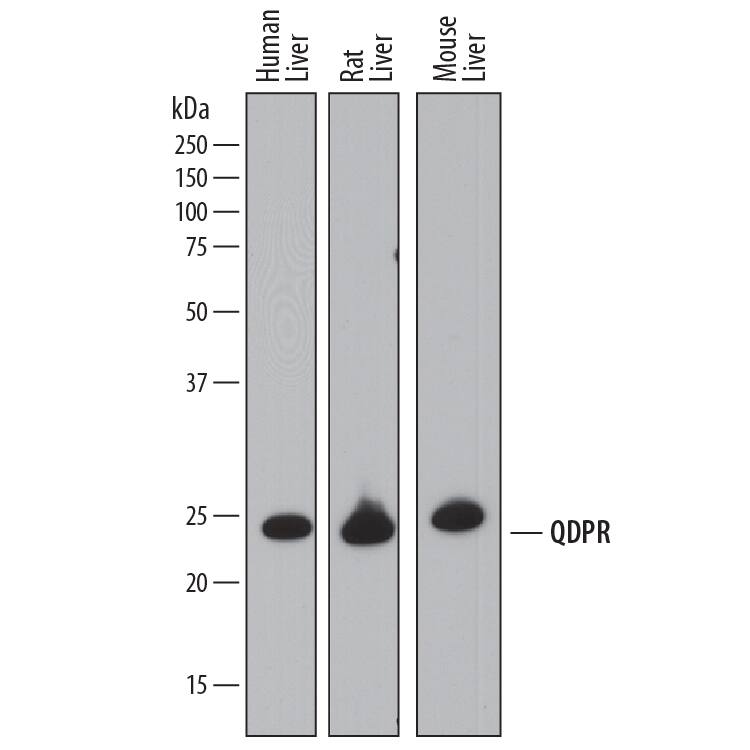Human/Mouse/Rat QDPR Antibody
R&D Systems, part of Bio-Techne | Catalog # AF8038

Key Product Details
Species Reactivity
Applications
Label
Antibody Source
Product Specifications
Immunogen
Ala2-Phe244
Accession # P09417
Specificity
Clonality
Host
Isotype
Scientific Data Images for Human/Mouse/Rat QDPR Antibody
Detection of Human, Mouse, and Rat QDPR by Western Blot.
Western blot shows lysates of human liver tissue, rat liver tissue, and mouse liver tissue. PVDF membrane was probed with 1 µg/mL of Sheep Anti-Human/Mouse QDPR Antigen Affinity-purified Polyclonal Antibody (Catalog # AF8038) followed by HRP-conjugated Anti-Sheep IgG Secondary Antibody (Catalog # HAF016). A specific band was detected for QDPR at approximately 25 kDa (as indicated). This experiment was conducted under reducing conditions and using Immunoblot Buffer Group 1.Applications for Human/Mouse/Rat QDPR Antibody
Western Blot
Sample: Human liver tissue, rat liver tissue, and mouse liver tissue
Formulation, Preparation, and Storage
Purification
Reconstitution
Formulation
Shipping
Stability & Storage
- 12 months from date of receipt, -20 to -70 °C as supplied.
- 1 month, 2 to 8 °C under sterile conditions after reconstitution.
- 6 months, -20 to -70 °C under sterile conditions after reconstitution.
Background: QDPR
QDPR (Quinoid DihydroPteridine Reductase; also DiHydroPteridine Reductase/DHPR) is a 25-26 kDa member of the Short-chain Dehydrogenase/Reductase (SDR) family of enzymes. Its alternative designation (DHPR) should not be confused with the 180-200 kDa dihydropyridine receptor, also known as DHPR, or 120 kDa bacterial dihydrodipicolinate reductase, also known as DHPR. QDPR is widely expressed, and found in cells such as fibroblasts, neurons, hepatocytes and lymphocytes. QDPR serves as a generator of a cofactor that is used in both nitric oxide and neurotransmitter production. Tyrosine and tryptophan are precursors for serotonin and dopamine, respectively. These final neurotransmitter endproducts are generated through a two-step process, the first involving the action of Tyr and Trp-specific hydroxylases. These two hydroxylases have an absolute requirement for BH4 (tetrahydrobiopterin), which is generated through the action of QDPR on q-BH2 (quinonoid dihydrobiopterin). Human QDPR is 244 amino acids (aa) in length. It contains one enzymatic region (aa 9-230) plus a utilized acetylation site at Ala2. QDPR functions as a nondisulfide-linked homodimer. There are four potential isoform variants, one that contains a 3 aa insertion after Gly218, another that shows a deletion of aa 36-66, a third that contains a five aa substitution for aa 147-244, and a fourth that utilizes an alternative start site at Met56. Pathologic conditions are associated with single aa substitutions at multiple sites, including Gly17, Gly23, Gln66 and His158. Full-length human QDPR (aa 1-244) shares 93% aa sequence identity with mouse QDPR.
Long Name
Alternate Names
Gene Symbol
UniProt
Additional QDPR Products
Product Documents for Human/Mouse/Rat QDPR Antibody
Product Specific Notices for Human/Mouse/Rat QDPR Antibody
For research use only
